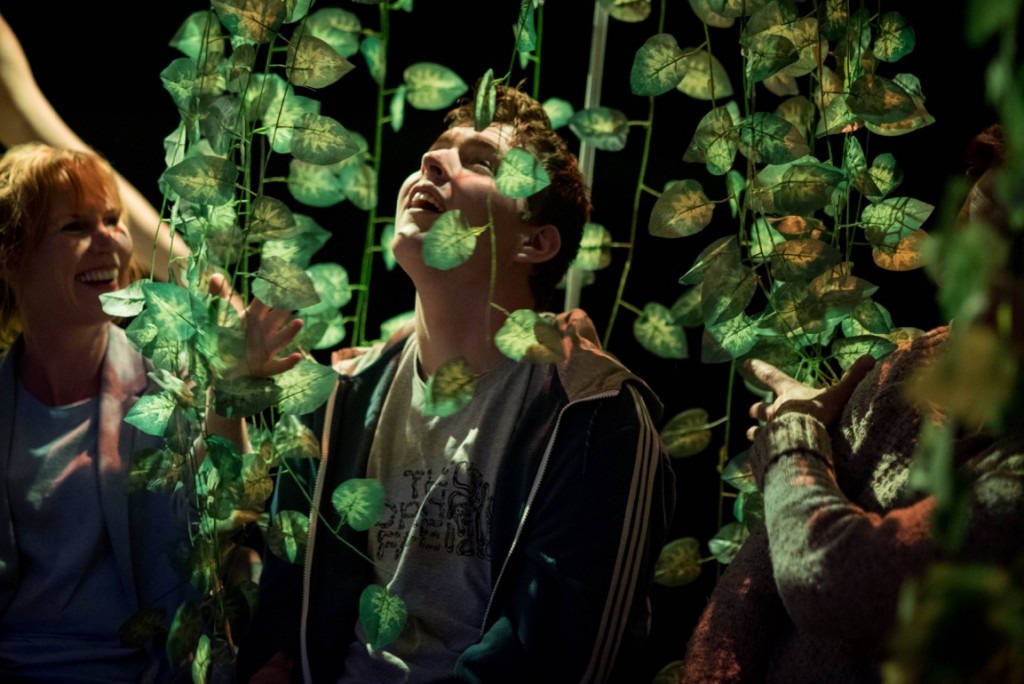
“Today is different” is a recurrent phrase in the latest show from theatre group Frozen Light. But the refrain is more than just part of the script; the words also reflect the innovative company’s hope for young people with profound disabilities.
The plot of the accessible, inclusive and multi-sensory play involves a journey of self-discovery for the main characters, Thea (Amber Onat Gregory) and Robin (Al Watts). Both dream of escaping their humdrum hometown existence, and a series of unexpected events, explained by narrator Ivy (Lucy Garland), result in a forest adventure, which changes their lives.
Frozen Light, led by co-artistic directors Garland and Gregory, is among a handful of companies that devise productions especially for people with profound and multiple learning disabilities (PMLD). While cultural access and inclusion have improved in recent years (projects like Autism Friendly Screenings are part of a burgeoning movement), the arts barrier remains down to people with complex physical and cognitive issues.
The group is currently on a nationwide tour of high street theatres and arts spaces. Garland and Gregory say many of their audience members have never before been into a mainstream theatre: “We want to enable people who rarely attend high street arts venues to experience the theatre. With our 26-date tour, we hope to reach as many people with PMLD as possible…We want people with profound needs to be more visible in their local areas.”
Recent work from the Lancaster Centre of Disability Research suggests there are over 16,000 people in England with PMLD, with an average area home to 78 adults with such needs. Think about where you live, when did you last see someone with profound disabilities on your high street, let alone any of your arts and community venues?
Performing to a maximum of 12 people – six people with disabilities, each supported by a carer, the three-strong cast accompanies the audience from the foyer into the performance space, ensuring a smooth transition into the theatre environment. One-to-one interactions include actors singing or talking directly to an audience member, or offering a prop to be touched. The specially composed music is pitched at an appropriately sensitive level.
In the audience for the opening performance of the tour at the Gulbenkian in Canterbury, Kent, I was drawn into the show’s multi-sensory world; swathed by leaves with a warm breeze on my skin, I could smell forest fruits and the scent of a wood after rainfall (I’m not taking poetic liberties – this is a factual description of how the show sparks your senses). The actors captivate the audience with the use of simple props and, I won’t spoil it, but the combined effect of helium balloons, LEDs, torches and white discs is quite hypnotic.
It was noticeable how much time the actors spent with each person, adapting their interactions – language and behaviour – according to need, ability and interest. One young boy who particularly enjoyed the feel of rain drops on his hands was allowed time to explore the sensations and appearance of drizzle. His joyful reaction was priceless.
Given I write and read so much about (warning: social care jargon alert) “choice and control” and “person-centred planning” or “personalisation” (ie when the unambitious “choice and control” box ticking basically means offering someone the choice between water or tea to drink..) – this was truly “person-centred” performance.
I did some editorial support work the company some months ago and, having come across the show in its conceptual infancy, I was blown away – almost literally, given the multi-sensory context – to see the fully fledged performance (a note of transparency here: this blogpost is mine and mine alone, written in my own time and, like every post on this site, independent, unsolicited and unpaid for).
Talking to parents and carers in the foyer after the show, several told me how their young people are starved of theatre that is tailor-made with complex needs in mind, but which also manages to be high quality and pitched at the right level for the audience (ie unpatronising).
One father told me his visually impaired son’s attention span was short, but he was moved to see the teenager captivated by sound, scent, taste and touch during the performance.
After the show’s premiere at the New Wolsey Theatre, Norwich, website The Public Reviews described The Forest as “the ultimate 3D live interactive performance”, and this detailed review by Max J Freeman is worth reading too for its reflection of the audience’s thoughts. And this Guardian piece by Frozen Light explains how the group stages its work for its audience.
Provoking some thought and evoking the senses, The Forest leaves you wondering why every day can’t be as different for its audience as “today”.
